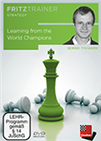A balanced field
The semifinals of the Aimchess US Rapid see Magnus Carlsen playing against Levon Aronian and Alireza Firouzja facing Vladislav Artemiev. If it were not for Aronian, who as we know is transferring to the US Federation, said federation, mentioned in the title of the tournament, would not be represented in the final rounds of the knockout phase.
The field of four is very balanced in terms of playing strength. Out of the eight games played on the first day of the semifinals, six ended in draws. The two decisive games were played in the ‘younger’ semi-final, between Artemiev and Firouzja.
Artemiev took the lead in the first game.
 These DVDs are about Understanding Middlegame Strategies. In the first DVD dynamic decisions involving pawns are discussed. The second DVD deals with decision making process concerning practical play.
These DVDs are about Understanding Middlegame Strategies. In the first DVD dynamic decisions involving pawns are discussed. The second DVD deals with decision making process concerning practical play.
A position from the Tarrasch variation of the Queen’s Gambit. Black has the isolani on d4, but he is also more active.
15.b4!? Nxb4 [15...Bxb4!? 16.Nxd4 Qxd4 17.Qxd4 Nxd4 18.Bxd4 Rae8 19.Bxa7 Rxe2=]
16.Nxd4 Bxd4 17.Qxd4 Qxd4 18.Bxd4 Nc6 [18...Nxa2 19.Rc5 did not please Black, as the white bishops exert some pressure. Black gives up a pawn, gets rid of the bishop pair and hopes to draw the game despite being down a pawn with opposite-coloured bishops.]
19.Bxc6 bxc6 20.Rxc6 Rfe8 21.e3 Rec8 22.Rcc1 Bd3 23.Rfe1 a5 24.g4 Bc4 25.a3 Be6 26.h3 a4 27.Kh2 Rxc1 28.Rxc1 Rc8 29.Rd1 Bb3 30.Rd3 f6 31.Kg3 Kf7 32.Bb6 Ke6 33.Ba5 h5 34.Bb4 hxg4 35.hxg4 Rc6 36.Rd8 Rc7 37.f4 g6 38.Rd6+ Kf7 39.e4 Re7 40.Kf3 Rc7 41.Ke3 Be6 42.f5 gxf5 43.gxf5 Bb3 Black’s game plan seems to be working. However, he has to suffer for a long time.
44.Rb6 Bc2 45.Kd4 Rd7+ 46.Ke3 Rc7 47.Re6 Bb3 48.Ra6 Bc2 49.Bd6 Rc3+ 50.Kf4 Bd1 51.Ra7+ Kg8
52.e5 Rc4+? [With 52...Rf3+ 53.Ke4 fxe5 54.Kxe5 Bb3 Black preserves his chances of a draw. White’s f-pawn cannot get to f7.]
53.Ke3 Rc6 [53...fxe5 54.f6 and the f-pawn decides.]
54.Ra8+ [54.e6 Rxd6 55.Rd7 also wins.]
54...Kh7 55.exf6 Bb3 56.Ra7+ Kg8 57.Rg7+ Kh8 58.Be5 Rc5 59.Bd4 1–0
Are you looking for an active defence against 1.d4? Look no further! The Tarrasch Defence (1.d4 d5 2.c4 e6 3.Nc3 c5) is one of Black's most ambitious ways to meet 1.d4.
Alireza Firouzja tied the score in the last game, by employing a ‘nasty’ trick.
28.Nb6!? Objectively not the best, but White has ulterior motives. [28.Ta1=]
28...Nxc5 29.Rd8 Rxd8 Black could not give up the back rank. [Necessary was 29...Kf7 and Black has a clear advantage.]
30.Rxd8 Nb7 31.Ra8 Tricked. The queen is attacked and there is a threat of Bh6.
31...Qxb6 [31...Qb5 32.Bh6+–]
32.Bxb6 Rxb6 Two minor pieces are too few for the queen. The game continued, though.
33.Nd2 Kg7 34.Nc4 Rb4 35.Ne3 Rb6 36.Nd5 Bxd5 37.exd5 c5 38.Qa4 Nd6 39.Qd7+ Nf7 40.Ra7 1–0
Select an entry from the list to switch between games
In the match between Magnus Carlsen and Levon Aronian all four games ended drawn. In the second game, Aronian gained an advantage by giving up an exchange, but then did not find the right continuation.
 With famous classical examples from the works of the giants, the author talks in detail about principles of chess and methods of play that we can use during every stage of the game.
With famous classical examples from the works of the giants, the author talks in detail about principles of chess and methods of play that we can use during every stage of the game.
25.Rxd6 cxd6 26.Nh4 Be4 27.f3? [27.Bxg7 Rh7 (27...Rg8 28.Bxh6) 28.Bf6 with good winning chances.]
27...g5 After the intermediate move, White’s advantage evaporates. [27...Bc6? 28.Nxg6+–]
28.Nf5 Bxf5 29.gxf5 Rg8 30.f4 gxf4+ 31.Kxf4 Ke7 32.Rg1 g6 33.f6+ Kxe6 34.Re1+ Kd7 35.Re7+ Kc6 36.f7 Rgd8 37.Bg7 d5 38.Re6+ Kb7 39.Re7+ Kc6 40.Re6+ Kb7 41.Re7+ Kc6 ½–½
We will find out who advances to the finals in Friday’s second set.

Click to enlarge
Links
























